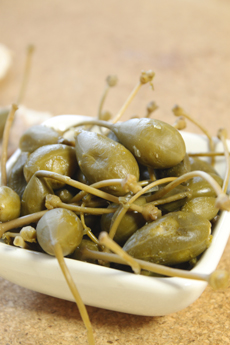
Caperberries or capers (capers are the flower bud of the plant, caperberries are the fruit with seeds inside) are brined and thus contribute saltiness as well as flavor to dishes. They and other ingredients (olives, soy sauce, etc.) reduce the need to add table salt (photo by Elvira Kalviste | © THE NIBBLE). |
|
Today’s tip comes from Flavor & The Menu, a magazine and website for chefs of fine dining restaurants. Just about any cook should be looking for ways to add more flavor to food.
They “employ every trick in the flavor toolbox to get explosive taste and texture,” according to author Pam Smith, co-chair of The Culinary Institute of America’s Healthy Menus R&D Collaborative. “Creating flavor is no magic trick,” she says, “but certain ingredients and techniques can magically make reduced-calorie dishes satisfying—even indulgent.”
The advice:
Acids. High-acid ingredients lend a sharp, bright flavor to replace salt or fat. Reduce wines and vinegars to concentrate their flavor; add a squeeze of citrus to finished dishes.
Cooking meats. Spices added to rubs and marinades brings out surface flavor, as does caramelization from grilling or searing meats.
Healthful fats. Beneficial fats and oils—nuts, seeds, vegetable oils, avocados—enhance mouthfeel and flavor.
Herbs. Savory* herbs (basil, dill, oregano, thyme, sage, cilantro) enable the reduction of salt. Finishing a dish with fresh herbs punches up the flavor.
High-sodium ingredients. Replace the salt in a recipe with more flavorful sodium: capers, feta, olives, olives or soy sauce, for example.
Onions. Members of the onion family, which also includes chives, garlic, scallions (green onions) and shallots, lend a sharp taste and aroma to dishes, whether raw, caramelized, roasted or grilled (how to caramelize onions).
|
|
Spices. Use spice and heat to distract the palate. Make use of strong flavors like cayenne, cumin, curry, ginger, horseradish/wasabi, mustard seed, and peppercorn. Toast whole spices before grinding to heighten the flavor and aroma.
Umami. Go for “exponential umami” by combining two nucleotide compounds, such as a burger made with beef and roasted mushrooms or tuna with a dash of soy sauce (more about umami).
What are you cooking this weekend? Employ as many of these tricks as you can and see how they improve your recipes.
_________________
*As opposed to savory herbs, sweet herbs are typically used to flavor beverages and desserts. Examples include apple mint, lavender, peppermint, pineapple mint, pineapple sage, and rose geranium. Savory herbs used in sweet applications include anise, basil, licorice and rosemary. Stevia is a sweet herb that is largely a sugar substitute, adding sweetness without additional flavor.
CHECK OUT WHAT’S HAPPENING ON OUR HOME PAGE, THENIBBLE.COM.
|



